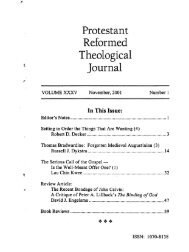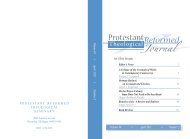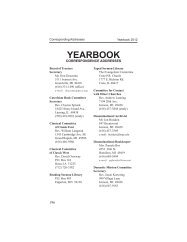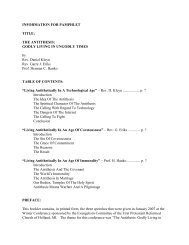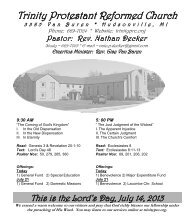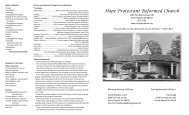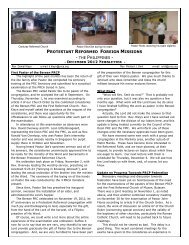November 2007 - Protestant Reformed Churches in America
November 2007 - Protestant Reformed Churches in America
November 2007 - Protestant Reformed Churches in America
Create successful ePaper yourself
Turn your PDF publications into a flip-book with our unique Google optimized e-Paper software.
<strong>Protestant</strong> <strong>Reformed</strong> Theological Journal<br />
place of the Savior is the redeemer mother earth, with its host of<br />
spirits and demons. People learn to identify themselves with this<br />
mother earth <strong>in</strong> Christian workshops.<br />
It is no longer all about reconciliation with God, the Almighty,<br />
the Holy One, but about reconciliation with the circles (circulation)<br />
of nature. Instead of attempt<strong>in</strong>g to overcome this world<br />
through the hope for a new heaven and a new earth, they try to dip<br />
<strong>in</strong>to nature.<br />
It is from this position that these people criticize Holy Scripture.<br />
Thus a theologian writes: “Egypt, Babylonia, and India<br />
have still experienced the div<strong>in</strong>e <strong>in</strong> the unity of man and animal.<br />
But the election- and covenant-theology of the Old Testament is<br />
just an expression of human arrogance. …Whereas the contemporary<br />
myths of the Indians or Egyptians tried to capture the natural<br />
history of the world <strong>in</strong> huge spaces of time, the cosmos and its<br />
history <strong>in</strong> the Old Testament shr<strong>in</strong>k <strong>in</strong>to a history of a few thousand<br />
years.”<br />
The statement on the first page of the Bible that God created<br />
the world <strong>in</strong> six days is rejected <strong>in</strong> this “theology,” but not because<br />
it contradicts a Darw<strong>in</strong>istic-orientated worldview. (Darw<strong>in</strong>ism—with<br />
its struggle for life and its l<strong>in</strong>ear development of<br />
time—is thought to be a male-orientated philosophy.) The statement<br />
that God created this world <strong>in</strong> six days contradicts the view<br />
<strong>in</strong> which nature is regarded as a gigantic circulation (circle) of<br />
life and death. In this gaia-centric theology/philosophy it is not<br />
all about a hope that transcends death, but its highest value is the<br />
f<strong>in</strong>d<strong>in</strong>g of a balance between life and death. Death is no longer<br />
understood as the wages of s<strong>in</strong>, but rather it is seen as an eternal<br />
circulation, which is viewed as a prerequisite (condition) for life.<br />
Let me po<strong>in</strong>t out <strong>in</strong> this context that approximately a quarter<br />
of the Europeans believe <strong>in</strong> re<strong>in</strong>carnation, that is, <strong>in</strong> a rebirth with<strong>in</strong><br />
the eternal cycle of nature. This so-called gaia-centric theology<br />
is rooted <strong>in</strong> an animistic naturalism and a Ch<strong>in</strong>ese universism. In<br />
fact, it is the negation of biblical Christianity.<br />
As everybody knows, the prophets of the Old Testament stood<br />
up aga<strong>in</strong>st naturalism. For example, the prophets Amos and Hosea<br />
resisted to the death this mixture between God, who had delivered<br />
His people from slavery, and the heathen Baals and Asherahs.<br />
50<br />
Vol. 41, No. 1



